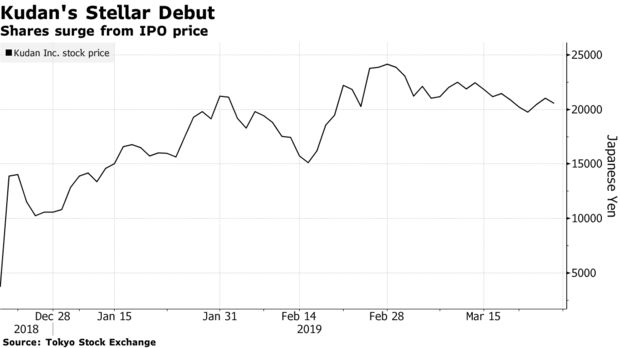By Yoojung Lee and Min Jeong Lee
April 2, 2019, 10:00 AM MDT | Updated on April 3, 2019, 4:51 AM MDT

When he graduated from university in Japan, Tomohiro Ohno didn’t know what he wanted to do. But he knew what he didn’t want to do, which was work for a traditional Japanese company.
So he ended up founding a firm that’s more space age than staid: Ohno was an early mover into augmented reality. The company he started, Kudan Inc., is developing programs that enable computers to have the equivalent of human eyes, using what Ohno and his industry call computer vision algorithms.
Kudan listed on the Tokyo Stock Exchange in December. It was a sparkling debut. The stock shot up more than sixfold to a high at the end of February, which saw his fortune top $800 million. While it has since given up some of those gains, the market value is still about $1.3 billion, and Ohno owns more than half the shares. He’s currently estimated to have a net worth of about $700 million, according to the Bloomberg Billionaires Index. Still, the 49-year-old entrepreneur is far from getting carried away.
‘Ridiculous Amount’
“It’s a ridiculous amount,” Ohno, who goes by “Tomo,” said in an interview in Tokyo. “That doesn’t mean anything. We’re not aiming to increase market value,” he said. “It doesn’t really impact us.”
While people often associate augmented reality with Pokemon Go, the hit mobile game that makes images of anime characters seem as if they’re in users’ real-world locations, Ohno says the technology is so much more than that. “I’ve nothing against Pokemon Go,” he said. “But after all, it’s just showing Pikachu” — one of the characters — “in the corner of the room.”
Kudan is deploying the technology for different purposes. It’s developing programs that enable computers to perceive real-world objects in three dimensions. They have uses in everything from driverless cars to drones and even vacuum cleaners. It works with other technologies such as artificial intelligence to enhance the autonomous and interactive experience.
Brain, Eyes
“AI is the brain and we are the eyes,” said Ohno, who started his career as a management consultant before working at a startup in Bristol, U.K. and then founding his own business buying and selling computer-game licences. “The eyes and brain need to work together.”
Kudan recently announced a partnership with California-based Synopsys Inc. to have its technology embedded into Synopsys products, which cover markets from mobile to automotive. While Ohno says making his company massive isn’t his main goal, this kind of alliance helps Kudan gain exposure.
“We don’t want to be the next Google,” Ohno said. He wants Kudan to be more like ARM Holdings, the chip designer owned by SoftBank Group Corp. whose technology is in most smartphones. “ARM is massive, but tiny compared to Intel. But it’s everywhere. That’s where we want to go.”
Kudan initially focused on using augmented reality for marketing, according to Ohno. No one was successful in making the technology easily digestible to ordinary people at the time, giving the company a good business opportunity, he said. But soon, a bigger firm doing similar things emerged as a competitor. That caused Kudan to come up with a strategy of making competitors its customers, instead of defending its turf.
‘Highly Rated’
The process involved switching the company’s business model from using AR for marketing to developing apps using the technology and finally becoming a provider of algorithms to other companies. Kudan’s chief technology officer, John Williams, who Ohno calls a “self-taught genius” and his best friend, convinced him to move away from apps into the underlying technologies, Ohno said. Now, Kudan has a wider customer base, including previous competitors, he said.
“It’s a highly rated stock among investors,” said Tomoichiro Kubota, an analyst at Matsui Securities Co. in Tokyo. But there is “the risk of seeing a company with a similar model popping up,” he said. And “the other side of expectations being high is that we’re in a situation where there’s been quite a bit of buying, and it’s looking expensive.”
Kudan trades at more than 150 times book value, and more than 35,000 times earnings, which were negligible for the fiscal year ended March 31, 2018. The stock fell 1.2 percent on Wednesday in Tokyo, paring this year’s gain to 93 percent.

That won’t unduly concern Ohno, who is more focused on developing the business and other goals, such as setting up a unit in China and taking it public. He’s still based in Bristol, where his company’s technology lab is located. Kudan has fewer than 20 employees, many of whom have Ph.D. degrees from a computer vision laboratory at the University of Bristol. Ohno said the company hires only experts in their field, and shuns meetings as unnecessary, because his people already know what to do.
The office in Bristol is situated in a former church. Ohno’s seat has a five-meter stained-glass window directly behind him, which shines a glow of light over him on sunny days. Asked if he has plans to move to a new location, he said he’s happy where he is.
“I do look like a god there,” he said.
(Updates with details on stock performance in 13th paragraph. A previous version was corrected to remove a photograph.)
